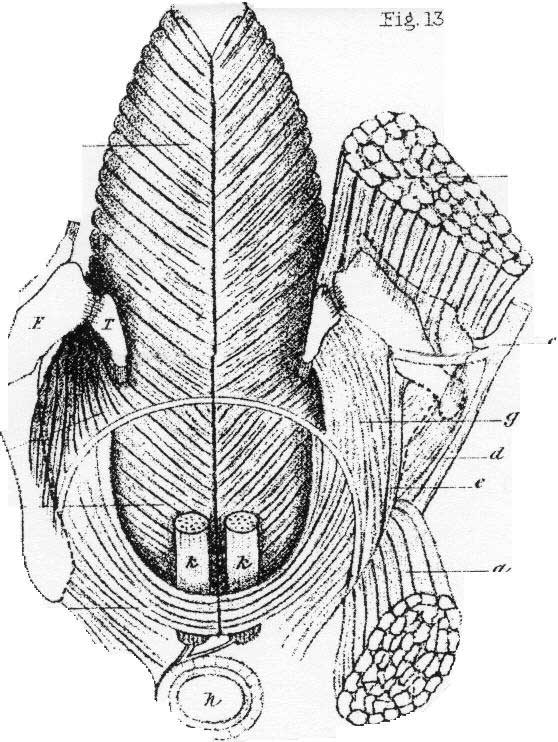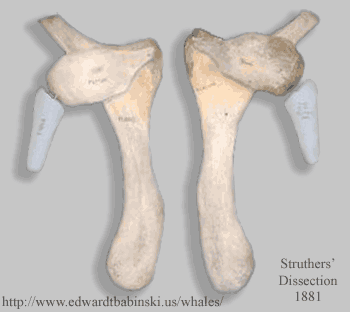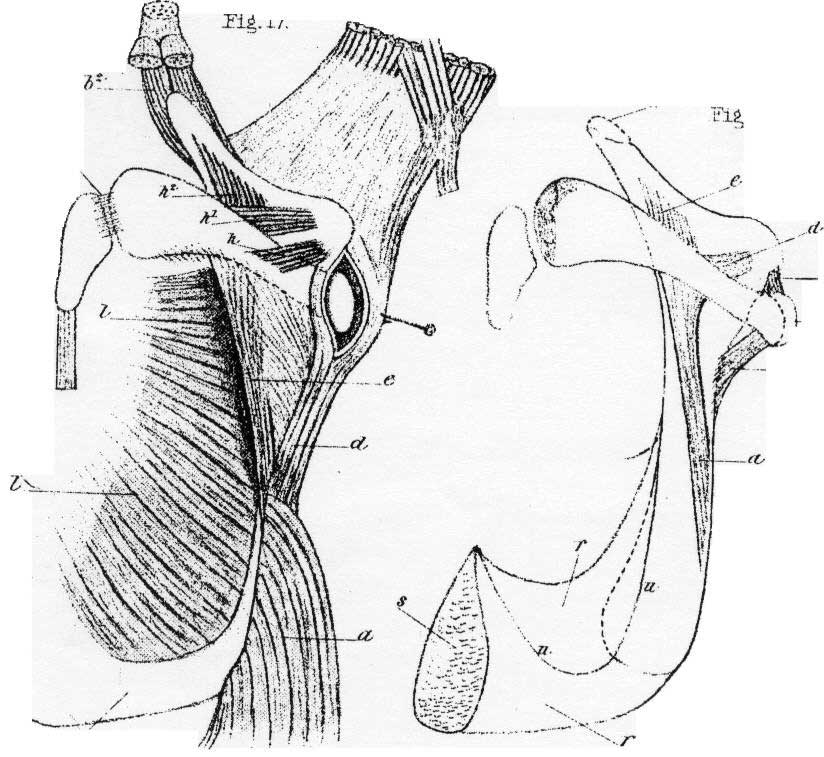HIND LIMB RUDIMENTS FOUND ON MODERN DAY WHALES
EXAMPLE #5
Here are some interesting facts concerning the pelvic anatomy of the majority of modern day whales, rather than the rare exceptions already noted above:
"The existence of a pair of small pelvic bones is known to exist in nearly all of the Cetacea, lying far apart from the vertebral column on both sides of the genital opening. However, in the Fin Whale, the Blue Whale, and the Humpback, the femur too is present near the pelvis. [Even in the Sperm Whale the femur is sometimes present (in the form of a small round-shaped bone near the pelvis). - E.T.B.] And in the Right Whale not only the femur but also the tibia exists. Of course these bones are buried deeply under the skin, causing no protuberance on the body surface." [Ogawa]

Right whale picture 1
the Femur and Tibia of the Right Whale
This goes with EXAMPLE #5
F = Femur (thigh bone)
T = Tibia (lower leg bone)
SEE THE TWO DIAGRAMS OF THE RIGHT WHALE'S PELVIS, FEMUR AND TIBIA (based on dissections by Struthers)
"Nothing can be imagined more useless to the animal than rudiments of hind legs entirely buried beneath the skin of a whale, so that one is inclined to suspect that these structures must admit of some other interpretation. Yet, approaching the inquiry with the most skeptical determination, one cannot help being convinced, as the dissection goes on, that these rudiments [in the Right Whale] really are femur and tibia. The synovial capsule representing the knee-joint was too evident to be overlooked. An acetabular cartilage, synovial cavity, and head of femur, together represent the hip-joint. Attached to this femur is an apparatus of constant and strong ligaments, permitting and restraining movements in certain directions; and muscles are present, some passing to the femur from distant parts, some proceeding immediately from the pelvic bone to the femur, by which movements of the thigh-bone are performed; and these ligaments and muscles present abundant instances of exact and interesting adaptation. But the movements of the femur are extremely limited, and in two of these whales the hip-joint as firmly anchylosed, in one of them on one side, in the other on both sides, without trace of disease, showing that these movements may be dispensed with. The function point of view fails to account for the presence of a femur in addition to processes from the pelvic bone. Altogether, these hind legs in this whale present for contemplation a most interesting instance of those significant parts in an animal -- rudimentary structures." [Struthers, p. 142-143]
SOURCES:
Struthers, John, M.D., Professor of Anatomy in the University of Aberdeen. (1881) "On the Bones, Articulations, and Muscles of The Rudimentary Hind-Limb of the Greenland Right-Whale (Balaena mysticetus)."
Journal of Anatomy and Physiology (London), Vol. 15, p. 141-321.
Ogawa, R., and Kamiya, T. A. (1957) "Case of the Cachalot [Sperm Whale] With Protruded Rudimentary Hind Limbs." Scientific Reports of the Whales Research Insititute, No. 12, p. 197-208.

The hind-limb bones that Struthers dissected from the right whale are still on display in the Zoology Museum at Aberdeen.
Whales have a number of vestigial structures that would have been fully functional in their land-living ancestors, including the pelvic girdle, the hind limbs and the finger muscles. The forelimbs of whales, which are used for steering, are stiff and paddle like and the muscles of the fingers, although still present, are much reduced, largely non-contractile and act more in the fashion of ligaments.

Source: Zoology Museum at Aberdeen
Struthers, J. (1871) On some points in the anatomy of a great fin whale (Balaenoptera musculus). J. Anat. Physiol. VI. 107-125.

Another diagram showing the dissected Pelvis, Femur and Tibia of the Right Whale.
What's especially interesting about the Right Whale is the fact that Carl Wieland at Answers in Genesis in his article, "The Strange Tale of the Leg on The Whale," featured a photo of "the skeleton of a Greenland Right whale, with bony disease." Well, here are diagrams of a dissection of a perfectly healthy Right Whale, showing its pelvis, femur and tibia. Sure look like "rudimentary hind legs to me," there's the hip bone connected to the leg bone, and the leg bone connected to the shin bone. All hidden inside the body of the Right Whale. Struthers' dissections were performed over a century ago, and revealed them plain as day.


No comments:
Post a Comment